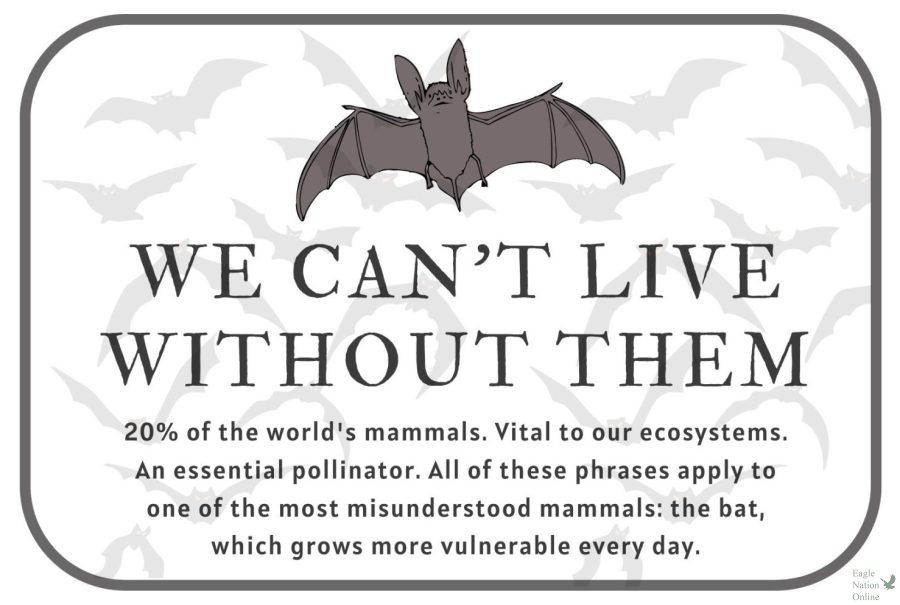Column: Bats — misunderstood animal faces endangerment, extinction
Writer discusses dangers bats face, ways Texans can help
In the attached column, writer Kalyani Rao shares that bats are extraordinarily valuable to the agriculture industry. In Texas alone, bats eat enough insects to save producers over $1.4 billion annually in just pest control costs. Currently, more than 15 bat species in the United States are currently listed as federally endangered, threatened or under review in the candidate or petition process under the Endangered Species Act. The above graphic was made using Canva.
August 31, 2022

Bats are the only mammals that are capable of true, sustained flight. They are also one of the most misunderstood and persecuted species that are essential to maintaining our ecosystems. According to the EcoHealth Alliance, losing bats, which is a very real possibility in the future due to the increasing vulnerability of bat populations, would translate to the loss of as much as 20% of the global mammal population. More than 15 bat species in the United States are currently listed as federally endangered, threatened, or under review in the candidate or petition process under the Endangered Species Act.
The perils of being a bat
All over the world, bats are feared and killed. The biggest danger bats face is persecution by humans. Local superstitions and preconceptions are the biggest driving force of those who purposely kill bats or even burn entire roosts. Some believe that bats are vampires, that they are dirty, bring diseases, or that they bring bad luck and death with them. Fears caused by the COVID-19 outbreak have made people all the more likely to kill bats – a huge detriment to conservation efforts.
Over 200 bats were killed in India with the outbreak of COVID-19 before the government imposed restrictions on the killing efforts. According to the National Resources Defense Council, in April 2020, Cubans in two provinces went after bat roosts in caves and buildings, exterminating the flying mammals with fire. Close afterwards, Rwandan government workers aimed water cannons on resting straw-colored fruit bats, hoping to drive them away from the capital city of Kigali. And in March 2020, the Peruvian government had to step in when people in the Cajamarca region descended on bat caves with lit torches. That month, the Indonesian government culled hundreds of live fruit bats for sale in food markets in what they said was an attempt to curb the COVID-19 pandemic.
According to the EcoHealth Alliance, losing bats, which is a very real possibility in the future due to the increasing vulnerability of bat populations, would translate to the loss of as much as 20% of the global mammal population.
These efforts are cruel and in vain. There is zero evidence that bats are responsible for passing COVID-19 to humans. According to the U.S. Fish and Wildlife Service, many bats are needlessly killed and persecuted because people do not understand the important role bats play in a healthy ecosystem. For bats that hibernate in caves, the need for winter shelter during hibernation puts them at another disadvantage. Human activity resulting in loss of habitat and disruptions during hibernation are detrimental.
Another danger to bats that isn’t persecution is white-nose syndrome — a fungal infection that has caused the decline of winter bat colonies by more than 70% in some regions. The role bats play on farmland in reducing pests and pollinating plants is so important that researchers predict the loss of bats would cost $3.7 billion per year in agricultural losses in just the United States. In Texas alone, bats eat enough insects to save producers over $1.4 billion annually in just pest control costs.
The exotic pet trade is another bat killer. Fruit bats, which can live up to 20 years in the wild, live less than a year on average in captivity. According to batworld.org, the act of keeping a bat as a pet will cause it to “experience terror, inappropriate and damaging nutrition and terrible loneliness and boredom”. Bats are often kept in tiny cages, never able to fly freely, and kept alone or if lucky, with one other bat. Bats are social animals and in the wild, live with thousands of bats. This social isolation causes most pet bats to die within a year of captivity.
Why bats are so important
Bats are incredibly essential in many different aspects required to maintain human life. Bats are pollinators to over 500 plants that require bats to pollinate them properly. Bees, which are drawn to brightly colored flowers, cannot replace the value of bats, which seek out pale and nocturnal flowers and plants such as species of mango, banana, cocoa, agave, guava, and durian. If these bats go extinct, chocolate will become a thing of the past.
More than 50% of the world’s rainforest is maintained by bats, according to the EcoHealth Alliance.
Being an essential pollinator is not the only job of a bat. Bats are excellent insect hunters. Scientists have discovered that some small bats can catch up to 1,000 or more small insects in a single hour. A nursing mother bat eats the most – sometimes catching more than 4,000 insects in a night.
The main diet of bats consists of fruits – which play a role in reforestation and maintaining our current rainforests. Bats fly over long distances to find meals, and after they digest the fruits, they disperse seeds through droppings that play a vital role in fertilizing soil and reforesting areas where trees have been cleared or natural forest has been fragmented. More than 50% of the world’s rainforest is maintained by bats.
Rural areas are not the only places that will be affected by the loss of bats. Urban bats play an important role in controlling pests in cities. Most of the ecosystems we know will suffer drastically if we don’t collectively work to preserve and grow the existing bat population.
Local ways you can help
There are large bat populations in Texas, especially along the border. In fact, there are 33 bat species in Texas, representing a diverse and growing bat population in North America.
Bats tend to gather in areas with large farms or agricultural lands, but that doesn’t mean they don’t exist in urban areas. Bracken Cave, just north of San Antonio, Texas, is home to about 20 million Mexican free-tailed bats. Texas cities like Houston, Austin, San Antonio, Fort Worth, Waco, Temple and College Station and the surrounding suburbs have higher bat populations. Warm temperatures and hot summers encourage bat activity.
Although bats are a necessary and beneficial presence in Texas and around the world, precautions must be taken as bats can carry rabies. To prevent the spread of the illness, bats should not be handled with bare hands, preferably at all.
According to Texas A&M’s AgriLife Extension, only a tiny percentage of bats in colonies carry rabies, but any bat found on the ground is more likely to be sick or injured.
Sanctuaries in Texas
Founded in 1994, the Bat World Sanctuary is a non-profit bat sanctuary, rehabilitation and rescue center in Weatherford, TX. The sanctuary operates through all of North Texas. They accept donations and volunteers, and for a donation of only $35 you can “adopt” a bat, which sponsors a bat in need and helps provide funds for the sanctuary to continue operating. Sponsors get a certificate of adoption, a glossy matted picture of their bat, a written copy of the bat’s personal story prior to being rescued, a bat rescue card, a bookmark, an online subscription to Night Flight News emails and more.
The Austin Bat Refuge is a non-profit rehabilitation, conservation and rescue center. Austin is considered the “bat capital” of North Texas. According to the Austin Bat Refuge website, they take in orphaned and injured local bats found all over Central Texas and the Houston area.
Together, we can fight to preserve bat habitats and grow the declining bat population.





















